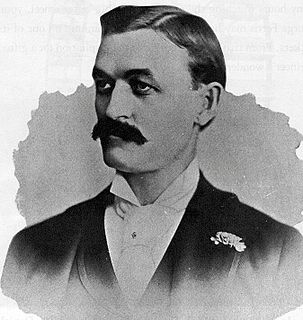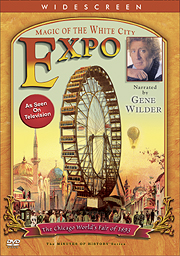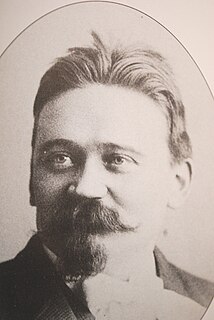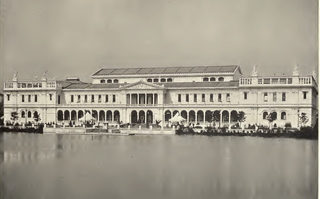
The World's Columbian Exposition was a world's fair held in Chicago in 1893 to celebrate the 400th anniversary of Christopher Columbus' arrival in the New World in 1492. The centerpiece of the Fair, held in Jackson Park, was a large water pool representing the voyage Columbus took to the New World. Chicago had won the right to host the fair over several other cities, including New York City, Washington, D.C., and St. Louis. The exposition was an influential social and cultural event and had a profound effect on architecture, sanitation, the arts, Chicago's self-image, and American industrial optimism.

A world's fair or world fair is a large international exhibition designed to showcase achievements of nations. These exhibitions vary in character and are held in different parts of the world at a specific site for a period of time, ranging usually from three to six months.

Steger is a village that straddles the border which separates Cook County and Will County, Illinois. It is 35 miles (56 km) south of Chicago and had a population of 9,570 at the 2010 census.

A Ferris wheel is an amusement ride consisting of a rotating upright wheel with multiple passenger-carrying components attached to the rim in such a way that as the wheel turns, they are kept upright, usually by gravity. Some of the largest modern Ferris wheels have cars mounted on the outside of the rim, with electric motors to independently rotate each car to keep it upright. These wheels are sometimes referred to as observation wheels and their cars referred to as capsules. However, these alternative names are also used for wheels with conventional gravity-oriented cars.

George Washington Gale Ferris Jr. was an American civil engineer. He is mostly known for creating the original Ferris Wheel for the 1893 Chicago World's Columbian Exposition.

Jackson Park is a 500-acre (2 km²) park located at 6401 South Stony Island Avenue in the Hyde Park and Woodlawn communities on the South Side in Chicago, Illinois. It borders onto Lake Michigan and several other South Side neighborhoods. Named for Seventh President Andrew Jackson, it is one of two Chicago Park District parks with the name "Jackson", the other being Mahalia Jackson Park for the gospel music singer in the Auburn Gresham community on the far southwest side of Chicago.

A midway at a fair is the location where carnival games, amusement rides, entertainment, dime stores, themed events, exhibitions and trade shows, pleasure gardens, water parks and food booths cluster.

The Midway Plaisance, known locally as the Midway, is a Chicago public park on the South Side of Chicago, Illinois. It is one mile long by 220 yards wide and extends along 59th and 60th streets, joining Washington Park at its west end and Jackson Park at its east end. It divides the Hyde Park community area to the north from the Woodlawn community area to the south, 6 miles (10 km) south of the downtown "Loop", near Lake Michigan. Today, the Midway runs through the southern portion of the University of Chicago campus, with university and related buildings fronting it on both sides.

Viking is a Viking ship replica. It is an exact replica of the Gokstad ship recovered from Gokstadhaugen, a Viking Era burial mound in Sandefjord, Norway in 1880. Viking was featured at the World's Columbian Exposition at Chicago in 1893.
Richard W. Bock was an American sculptor and associate of Frank Lloyd Wright.

A traveling carnival, usually simply called a carnival, or travelling funfair is an amusement show that may be made up of amusement rides, food vendors, merchandise vendors, games of chance and skill, thrill acts, and animal acts. A traveling carnival is not set up at a permanent location, like an amusement park or funfair, but is moved from place to place. Its roots are similar to the 19th century circus with both being fitted-up in open fields near or in town and moving to a new location after a period of time. In fact, many carnivals have circuses while others have a clown aesthetic in their decor. Unlike traditional carnival celebrations, the North American traveling carnival is not tied to a religious observance.

Expo: Magic of the White City is a 2005 American direct-to-video historical documentary film directed and produced by Mark Bussler, and narrated by Gene Wilder. The documentary tells the story of Chicago's World's Columbian Exposition in 1893.

Dunns Bridge is an unincorporated community in Kankakee Township, Jasper County, Indiana, United States. It sits along the Kankakee River at the south end of two bridges over the river, connecting Jasper and Porter counties. The historic Dunns Bridge lies just west of a modern bridge that carries Porter County Road 500 East and Jasper County Road 400 East over the Kankakee.
White City is the common name of dozens of amusement parks in the United States, the United Kingdom, and Australia. Inspired by the White City and Midway Plaisance sections of the World's Columbian Exhibition of 1893, the parks started gaining in popularity in the last few years of the 19th century. After the 1901 Pan-American Exposition inspired the first Luna Park in Coney Island, a frenzy in building amusement parks ensued in the first two decades of the 20th century.

The Great Wheel, also known as the Gigantic Wheel, was built for the Empire of India Exhibition at Earls Court, London, in the United Kingdom. Construction began in March 1894 at the works of Maudslay, Sons and Field in Greenwich and it opened to the public on 17 July 1895. Modelled on the original Ferris Wheel which featured at the 1893 World's Columbian Exposition in Chicago, US, it was 94 metres (308 ft) tall and 82.3 metres (270 ft) in diameter. and weighed about 900 Tons. It stayed in service until 1906, by which time its 40 cars had carried over 2.5 million passengers. It was demolished in 1907 following its last use at the Imperial Austrian Exhibition.

Warren R. Briggs (1850–1933) was an American architect who worked in Bridgeport, Connecticut.

Johannes Sophus Gelert (1852-1923) was a Danish-born sculptor, who came to the United States in 1887 and during a span of more than thirty years produced numerous works of civic art in the Midwest and on the East Coast.

The Woman's Building was designed and built for the World's Columbian Exposition held in Chicago in 1893. It had exhibition space as well as an assembly room, a library, and a Hall of Honor. The History of the World's Fair states, "It will be a long time before such an aggregation of woman's work, as may now be seen in the Woman's Building, can be gathered from all parts of the world again."

The William McKinley statue is a monumental statue of William McKinley in Chicago, Illinois, United States. Located in the McKinley Park neighborhood, the statue was designed by Charles Mulligan and dedicated in 1905.





















